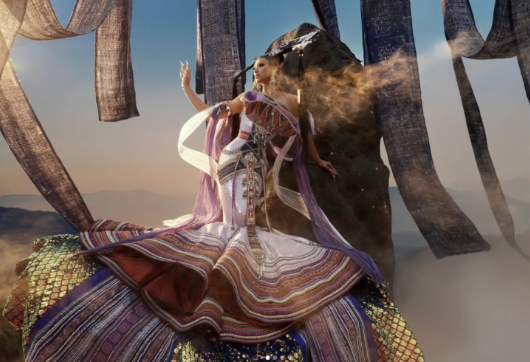Asian Fashion Representation in Film
We all have our own way of dressing that means something specific to us, whether it be creativity, identity, etc. The fashion within many cultures shares different meanings and values through traditional wear. Korea, Vietnam, and India fall on the same continent but express their different cultures through fashion, and the media of films highlight the most popular and well-known styles. Asian culture is shown in several ways, but their native fashion is unique, beautiful, and a representation of who they are.
In Korean culture, originally South Korea, Hanboks are commonly seen in the films, Pachinko (series) and Mr. Sunshine (A drama). The term hanbok means “Korean dress,” and that essentially is what hanboks are. The design of these garments varies depending on the occasion, status, or period. Materials such as cotton, silk, ramie, and hemp can be used in different variations of creating the garment. Breaking it down, hanboks include a flowy skirt with a loose short jacket or a blouse on top with vibrant colors. As time goes on, the design of the hanbok continues to sustain its historic accuracy while allowing designers to use creative liberties.
The most popular Vietnamese piece in the media is known as the áo dài. The films The Tailor (Cô Ba Sài Gòn) and The White Silk Dress (Áo Iya Hà Ðông) both feature the traditional Vietnamese piece. The áo dài is a long tunic with a form-fitting silhouette that has a high neckline and wide slits, over wide leg trousers made of the same materials. Originally, they were made to be white and red, but now we see this style in other vibrant colors. This garment stands for many messages; it is a symbol of power and the embodiment of elegance and grace. They are most worn for celebrations or special occasions. This garment represents a national identity by posing as a symbol for its spirit and history. The symbolic nature of the áo dài stays the same, as the style adapts to the sociocultural changes.
Many types of traditional Indian wear are featured throughout films, but the most common attire consists of the Salwar Kameez and Sherwanis. The world of Bollywood presents an increasing number of different traditional garments in each film - you’ll be sure to spot a few Salwar Kameez’ and Sherwanis’. Salwar suits are some of the most versatile traditional wears in Indian culture. Similar to the áo dài, the salwar kameez is loose trousers (salwar) with a long tunic top (kameez). Some include an additional scarf called a dupatta. There are many variations of this salwar: punjabi, angarkha, anarkali, and frock styles. Sherwanis are easily recognizable in terms of men's fashion wear. They consist of luxury fabrics, silk, satin, etc., that creates a long, coat-style jacket that is most likely embellished; typically paired with churidar or dhoti pants. Sherwanis also have different variants of their own: achkan, indo-western, angrakha, and jodhpuri. This particular garment holds values of prestige, royalty, and a sense of cultural heritage for formal occasions.
These popular styles within the different cultures of Asia exemplify diversity and the values of natives. The films we are given also maintain the accuracy of traditional wear surrounding their cultures. We as viewers may not understand the cultural significance of these garments until we take it upon ourselves to educate and inform each other. The preservation of knowledge, act of celebration, and sense of community are strongly influenced by those who partake in traditional clothing wear. There are so many innovative ways to make it your own while simultaneously representing your heritage. Traditional wear is more than a reflection of yourself, it is a reflection of the history and values of your culture. Embracing your culture through your clothing choices opens a new world of beauty and appreciation.
Strike Out,
Amia King
Editor: Maya Kayyal & Jaden Rudd
Amia King is a journalism writer for Strike Magazine, Saint Augustine. She is fashion-obsessed, and you will more than likely find her thrifting an absurd number of belts and bags. She intends to pursue a career as a columnist and fashion critic, continuing her work in digital and print media. You can reach her through Instagram @amiarking_ or email @aking222005@gmail.com.


